How Pipe Material Affects Water Pressure, Drainage, and Repair Costs
July 15th, 2025
6 min read
By Daphne Hunt
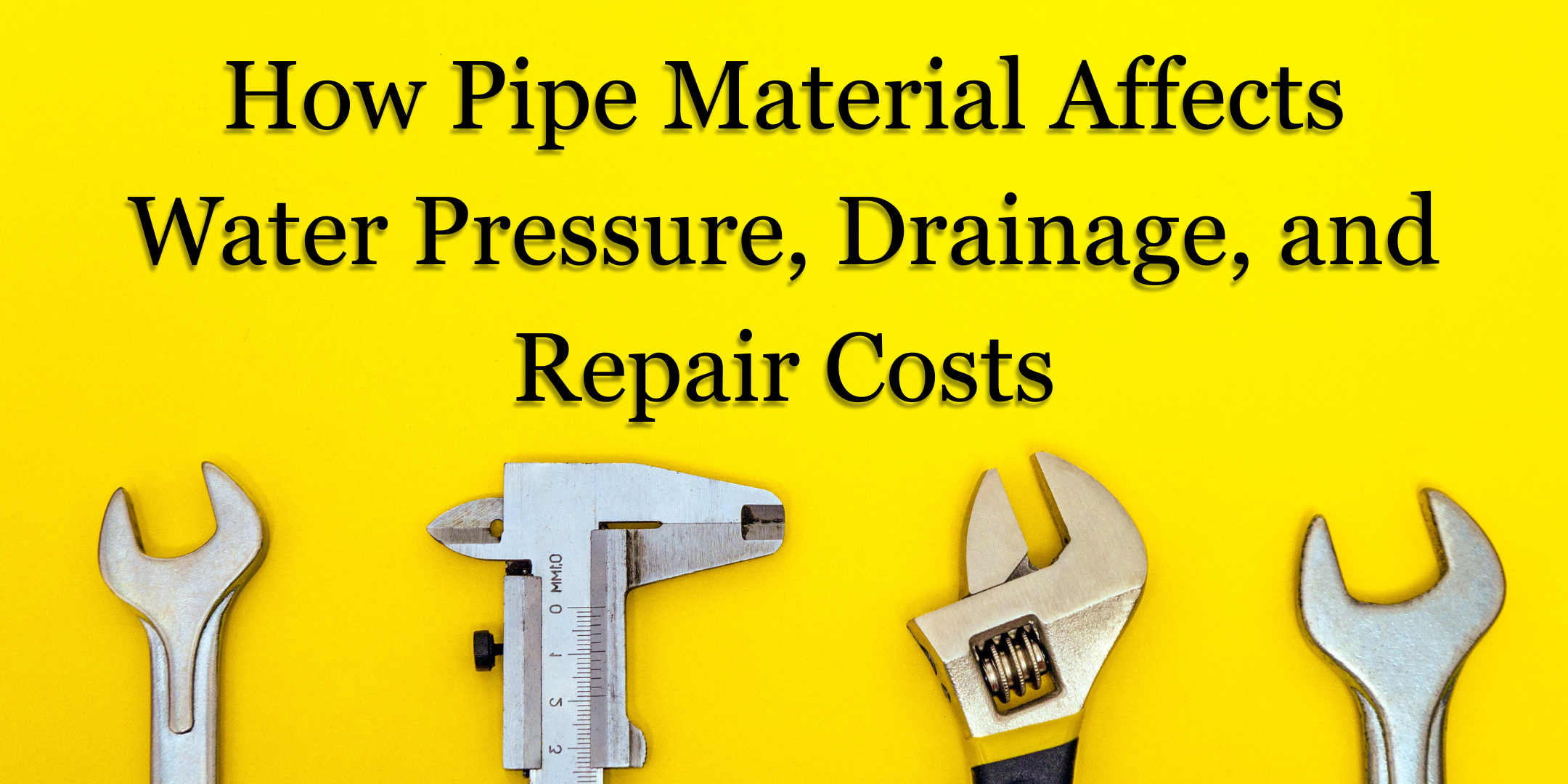
If your water pressure is dropping, your drains are acting up, or you’re seeing rust-colored water at the tap, your plumbing may be trying to tell you something—and it’s not always about the fixture. The type of piping behind your walls plays a major role in how well your system works, how long it lasts, and how much maintenance it really needs.
your plumbing may be trying to tell you something—and it’s not always about the fixture. The type of piping behind your walls plays a major role in how well your system works, how long it lasts, and how much maintenance it really needs.
Whether your home has PVC, PEX, copper, cast iron, or galvanized steel pipes, each material has its own strengths, risks, and care requirements. With over 17 years of experience working in homes across the Columbia River Gorge and the Gresham Portland metro area, we’ve seen every type of plumbing system—and every way they can surprise you.
By the end of this article, you’ll know how to identify your pipe type, understand what that means for maintenance and lifespan, and make confident decisions to keep your system running safely and efficiently.
How to Tell What Type of Plumbing You Have
You don’t need to open up walls or dig into your crawlspace to get a good idea of what kind of plumbing your home has. In most cases, you can identify pipe types just by looking under your sinks, behind your washing machine, or near your water heater.
Here are quick visual clues and details to help you narrow it down:
PVC Pipes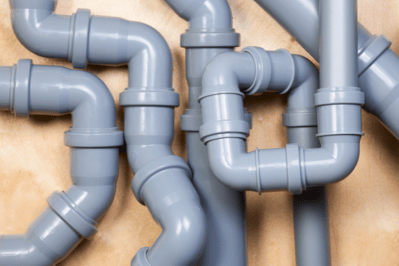
- Color/Texture: Bright white, grey, or cream plastic, smooth surface
- Common Use: Drain, waste, and vent lines
- Where Found: Homes built after the 1980s or recently remodeled
- Watch for: Cracks, loose joints, or warping near hot water sources
PEX Pipes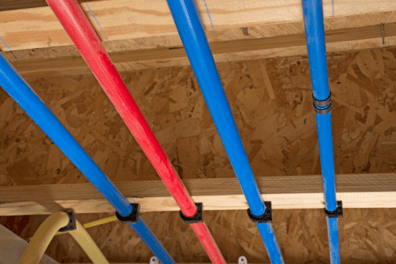
- Color/Texture: Flexible tubing, usually red, blue, or white; slightly translucent
- Common Use: Water supply lines in modern homes and renovations
- Where Found: Homes built after the mid-2000s or homes with newer additions
- Watch for: Loose fittings, UV exposure damage near windows or lights
Copper Pipes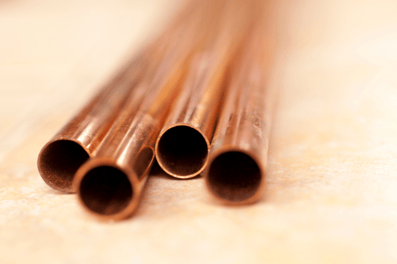
- Color/Texture: Reddish-brown metallic with potential green corrosion at joints
- Common Use: Water supply lines in mid-century and upscale homes
- Where Found: Homes built from the 1950s–2000s
- Watch for: Green staining, corrosion, or pinhole leaks along the pipe surface
Cast Iron Pipes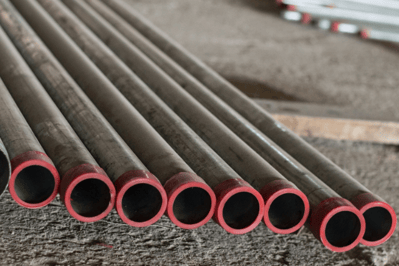
- Color/Texture: Very dark, almost black or rust-brown; thick and heavy
- Common Use: Main sewer and drain lines
- Where Found: Homes built before 1970, especially from 1900–1960
- Watch for: Slow drains, sewer smells, or flaking rust near floor drains
Galvanized Steel Pipes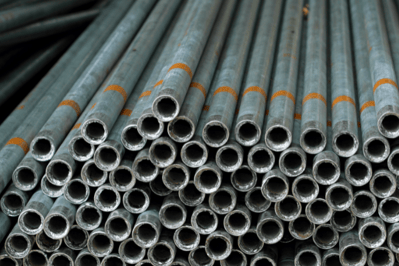
- Color/Texture: Dull silver-gray with threaded connections
- Common Use: Pressurized water lines in older homes
- Where Found: Homes built between the 1930s–1980s
- Watch for: Low water pressure, rust-colored water, or threaded fittings that leak
Still unsure what you’re looking at? It’s not uncommon to find more than one type of pipe in the same house—especially if it’s been renovated or repaired over the years. If you see a combination of plastic and metal, or you’re noticing discoloration, inconsistent pressure, or frequent clogs, those are signs it may be time for a full system inspection.
PVC Plumbing: Lightweight, Common, but Not Invincible
Installed in homes built after the 1980s (or during remodels)
Best for: Drain lines, vent systems, and some cold water supply
What it looks like: White, smooth plastic with clearly labeled fittings
Pros of PVC Pipes
- Doesn’t rust or corrode, making it a great option for humid or wet areas
- Affordable and easy to replace
- Lightweight and low maintenance
Cons of PVC Pipes
- Can warp if exposed to extreme heat (think boiling water or hot grease)
- Cracks more easily than metal if stressed or improperly supported
- Not always permitted for indoor potable water lines, depending on local code
If you’ve been treating your PVC drains like they’re indestructible—pouring hot grease or using chemical cleaners weekly—you may be accelerating cracks without realizing it. PVC performs well when it’s treated gently.
Cast Iron Plumbing: Solid, Silent, and Slowly Rusting
Common in homes built from 1900–1960s
Best for: Main drain and sewer lines
What it looks like: Black or rust-brown metal, very thick and heavy
Pros of Cast Iron Pipes
- Extremely durable—can last 80–100 years externally
- Naturally noise-dampening; you won’t hear water rushing through it
- Strong under pressure and resistant to impact
Cons of Cast Iron Pipes
- Prone to internal rust and scale buildup over time, which restricts flow
- Can crack or collapse from the inside out without visible warning
- Repairs and replacement are more labor-intensive and expensive
Cast iron tends to deteriorate quietly—so even if everything seems fine on the outside, problems could be lurking. Many homeowners don’t know their system is compromised until they start experiencing repeated clogs or slow drains, especially from multiple fixtures.
Galvanized Steel Plumbing: Strong Start, Weak Finish
Used in homes built between the 1930s and 1980s
Best for: Originally installed as pressurized water supply lines
What it looks like: Dull silver-gray with threaded joints; feels heavy and metallic
Pros of Galvanized Steel Pipes
- Was marketed as corrosion-resistant thanks to a zinc coating
- Provided a more durable alternative to lead piping (at the time)
- Strong, rigid, and structurally sound—at least early on
Cons of Galvanized Steel Pipes
- Zinc coating wears off, allowing rust and buildup to form inside
- Narrowing pipes cause low pressure, discolored water, and sediment in fixtures
- May contain lead in solder joints or fittings, especially in homes built before 1986
Galvanized pipes are often the hidden culprit behind mysteriously low pressure or water that’s slow to clear from your tub. They can look perfectly intact externally—even while rust is choking the system from within. And if one section is corroding, it’s safe to assume the rest aren’t far behind.
PEX Plumbing: Flexible, Quiet, and Low-Fuss
Common in homes built after the early 2000s
Best for: Water supply lines in new builds and modern remodels
What it looks like: Colored tubing (usually red, blue, or white), slightly translucent, and flexible
Pros of PEX Pipes
- Highly flexible, which makes installation easier and reduces the chance of burst pipes in freezing weather
- Quiet operation, with fewer water hammer issues than rigid metal pipes
- Resistant to scale buildup and not affected by acidic water
- Typically more affordable than copper
Cons of PEX Pipes
- Can degrade when exposed to sunlight—even small amounts of UV over time will weaken it
- Not immune to damage from rodents, sharp objects, or tight bends if installed without support
- Some local codes still restrict PEX use in certain applications
PEX is great for homes where flexibility and freeze-resistance matter—but homeowners should be aware that it’s not invincible. If you’ve had remodel work done recently and noticed tubing instead of metal lines, it’s worth checking whether your PEX is properly protected from UV exposure or overly tight installation spaces.
Copper Plumbing: Durable, Classic, and Surprisingly Sensitive
Common in homes built between the 1950s and early 2000s
Best for: Potable water supply lines
What it looks like: Reddish-gold metal pipe, often joined with soldered fittings; can develop green or bluish corrosion
Pros of Copper Pipes
- Long-lasting and highly reliable, often with a 50–70+ year lifespan
- Naturally antimicrobial and corrosion-resistant
- Performs well under pressure and in high-heat environments
- Doesn’t sag or require as much support as flexible piping
Cons of Copper Pipes
- Expensive to install and repair, especially if soldering is required
- Vulnerable to pinhole leaks from internal corrosion, especially in areas with acidic or aggressive water
- Metal theft has made copper more costly and occasionally targeted in vacant properties
- Prone to galvanic corrosion when connected to other metals without proper fittings
If your home has copper pipes and you’ve noticed staining around fittings or metallic-tasting water, it may be time to test your water’s pH or hardness levels. While copper is one of the most trusted materials in plumbing, poor water chemistry can quietly shorten its lifespan.
What Does Pipe Type Mean for You?
If you’ve been dealing with low water pressure, rusty-looking water, or drains that gurgle even after you’ve cleaned them—your pipe material may be the root of the problem, not the symptom. And depending on what type you have, the solution (and the urgency) changes.
For example:
- If you have galvanized steel, that slow pressure drop might not be your faucet—it could be decades of
 mineral buildup inside narrowing your pipes.
mineral buildup inside narrowing your pipes. - If your home still uses cast iron for drains, those recurring clogs could be from internal rust and scale—not a hairball or leftover pasta rinse.
- If your water supply is PEX or copper, pinhole leaks may be a sign of high water acidity or poor installation—not just “old pipes.”
- And if you’re seeing white PVC, it’s great that it doesn’t rust—but it can still crack from heat or pressure over time, especially if you’re pouring hot water or chemicals down the drain.
Your plumbing system isn’t just old or new—it has a personality. Each pipe type responds differently to stress, water chemistry, temperature, and time. That’s why what works for one home (like an enzyme-based drain cleaner or a quick patch) might backfire in another.
- It means that the more you know about what’s behind your walls, the more prepared you’ll be to:
- Catch small issues early—before they become wall-opening emergencies
- Choose the right kind of maintenance (not the stuff that damages your pipes)
- Decide when a repair is enough—and when it’s smarter to replace
You don’t need to be a plumber—but you do deserve to understand the system your home depends on every single day. Knowing your pipe type gives you the power to make smart, confident choices—and avoid surprise costs later.
What Kind of Pipes Do You Have—And What Should You Do About It?
Maybe your water pressure’s been off, your drains are backing up more than usual, or you’re just trying to avoid a surprise plumbing bill. Whatever led you here, chances are, you’ve been wondering if the problem is bigger than just a stubborn faucet or a single clogged line.
avoid a surprise plumbing bill. Whatever led you here, chances are, you’ve been wondering if the problem is bigger than just a stubborn faucet or a single clogged line.
You don’t have to be a plumbing expert to protect your home. But knowing what’s behind your walls gives you the clarity to ask better questions, avoid one-size-fits-all solutions, and take action that makes sense for your space, your budget, and your long-term peace of mind.
Want to make your pipes last longer? Check out our guide to maintaining your plumbing based on the material in your home. You'll learn exactly what to do (and what to avoid) for PVC, copper, PEX, cast iron, and galvanized steel in our article: "How to Maintain Your Plumbing Based on Pipe Type"
Daphne Hunt holds a bachelor's degree in English and Mass Communication and has a lifelong passion for writing. She thrives on using her skills to craft compelling pieces that inform, inspire, and connect with readers.
Topics:



